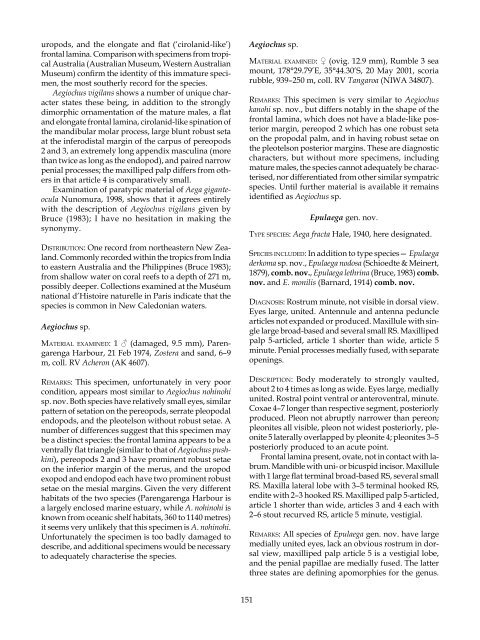The Marine Fauna of New Zealand: Isopoda, Aegidae (Crustacea)
The Marine Fauna of New Zealand: Isopoda, Aegidae (Crustacea)
The Marine Fauna of New Zealand: Isopoda, Aegidae (Crustacea)
You also want an ePaper? Increase the reach of your titles
YUMPU automatically turns print PDFs into web optimized ePapers that Google loves.
uropods, and the elongate and flat (‘cirolanid-like’)<br />
frontal lamina. Comparison with specimens from tropical<br />
Australia (Australian Museum, Western Australian<br />
Museum) confirm the identity <strong>of</strong> this immature specimen,<br />
the most southerly record for the species.<br />
Aegiochus vigilans shows a number <strong>of</strong> unique character<br />
states these being, in addition to the strongly<br />
dimorphic ornamentation <strong>of</strong> the mature males, a flat<br />
and elongate frontal lamina, cirolanid-like spination <strong>of</strong><br />
the mandibular molar process, large blunt robust seta<br />
at the inferodistal margin <strong>of</strong> the carpus <strong>of</strong> pereopods<br />
2 and 3, an extremely long appendix masculina (more<br />
than twice as long as the endopod), and paired narrow<br />
penial processes; the maxilliped palp differs from others<br />
in that article 4 is comparatively small.<br />
Examination <strong>of</strong> paratypic material <strong>of</strong> Aega giganteocula<br />
Nunomura, 998, shows that it agrees entirely<br />
with the description <strong>of</strong> Aegiochus vigilans given by<br />
Bruce ( 983); I have no hesitation in making the<br />
synonymy.<br />
distribution: One record from northeastern <strong>New</strong> <strong>Zealand</strong>.<br />
Commonly recorded within the tropics from India<br />
to eastern Australia and the Philippines (Bruce 983);<br />
from shallow water on coral reefs to a depth <strong>of</strong> 27 m,<br />
possibly deeper. Collections examined at the Muséum<br />
national d’Histoire naturelle in Paris indicate that the<br />
species is common in <strong>New</strong> Caledonian waters.<br />
Aegiochus sp.<br />
materiaL examined: ♂ (damaged, 9.5 mm), Parengarenga<br />
Harbour, 2 Feb 974, Zostera and sand, 6–9<br />
m, coll. RV Acheron (AK 4607).<br />
remarks: This specimen, unfortunately in very poor<br />
condition, appears most similar to Aegiochus nohinohi<br />
sp. nov. Both species have relatively small eyes, similar<br />
pattern <strong>of</strong> setation on the pereopods, serrate pleopodal<br />
endopods, and the pleotelson without robust setae. A<br />
number <strong>of</strong> differences suggest that this specimen may<br />
be a distinct species: the frontal lamina appears to be a<br />
ventrally flat triangle (similar to that <strong>of</strong> Aegiochus pushkini),<br />
pereopods 2 and 3 have prominent robust setae<br />
on the inferior margin <strong>of</strong> the merus, and the uropod<br />
exopod and endopod each have two prominent robust<br />
setae on the mesial margins. Given the very different<br />
habitats <strong>of</strong> the two species (Parengarenga Harbour is<br />
a largely enclosed marine estuary, while A. nohinohi is<br />
known from oceanic shelf habitats, 360 to 40 metres)<br />
it seems very unlikely that this specimen is A. nohinohi.<br />
Unfortunately the specimen is too badly damaged to<br />
describe, and additional specimens would be necessary<br />
to adequately characterise the species.<br />
5<br />
Aegiochus sp.<br />
materiaL examined: ♀ (ovig. 2.9 mm), Rumble 3 sea<br />
mount, 78°29.79’E, 35°44.30’S, 20 May 200 , scoria<br />
rubble, 939–250 m, coll. RV Tangaroa (NIWA 34807).<br />
remarks: This specimen is very similar to Aegiochus<br />
kanohi sp. nov., but differs notably in the shape <strong>of</strong> the<br />
frontal lamina, which does not have a blade-like posterior<br />
margin, pereopod 2 which has one robust seta<br />
on the propodal palm, and in having robust setae on<br />
the pleotelson posterior margins. <strong>The</strong>se are diagnostic<br />
characters, but without more specimens, including<br />
mature males, the species cannot adequately be characterised,<br />
nor differentiated from other similar sympatric<br />
species. Until further material is available it remains<br />
identified as Aegiochus sp.<br />
Epulaega gen. nov.<br />
type speCies: Aega fracta Hale, 940, here designated.<br />
speCies inCLuded: In addition to type species— Epulaega<br />
derkoma sp. nov., Epulaega nodosa (Schioedte & Meinert,<br />
879), comb. nov., Epulaega lethrina (Bruce, 983) comb.<br />
nov. and E. monilis (Barnard, 9 4) comb. nov.<br />
diagnosis: Rostrum minute, not visible in dorsal view.<br />
Eyes large, united. Antennule and antenna peduncle<br />
articles not expanded or produced. Maxillule with single<br />
large broad-based and several small RS. Maxilliped<br />
palp 5-articled, article shorter than wide, article 5<br />
minute. Penial processes medially fused, with separate<br />
openings.<br />
desCription: Body moderately to strongly vaulted,<br />
about 2 to 4 times as long as wide. Eyes large, medially<br />
united. Rostral point ventral or anteroventral, minute.<br />
Coxae 4–7 longer than respective segment, posteriorly<br />
produced. Pleon not abruptly narrower than pereon;<br />
pleonites all visible, pleon not widest posteriorly, pleonite<br />
5 laterally overlapped by pleonite 4; pleonites 3–5<br />
posteriorly produced to an acute point.<br />
Frontal lamina present, ovate, not in contact with labrum.<br />
Mandible with uni- or bicuspid incisor. Maxillule<br />
with 1 large flat terminal broad-based RS, several small<br />
RS. Maxilla lateral lobe with 3–5 terminal hooked RS,<br />
endite with 2–3 hooked RS. Maxilliped palp 5-articled,<br />
article shorter than wide, articles 3 and 4 each with<br />
2–6 stout recurved RS, article 5 minute, vestigial.<br />
remarks: All species <strong>of</strong> Epulaega gen. nov. have large<br />
medially united eyes, lack an obvious rostrum in dorsal<br />
view, maxilliped palp article 5 is a vestigial lobe,<br />
and the penial papillae are medially fused. <strong>The</strong> latter<br />
three states are defining apomorphies for the genus.

















